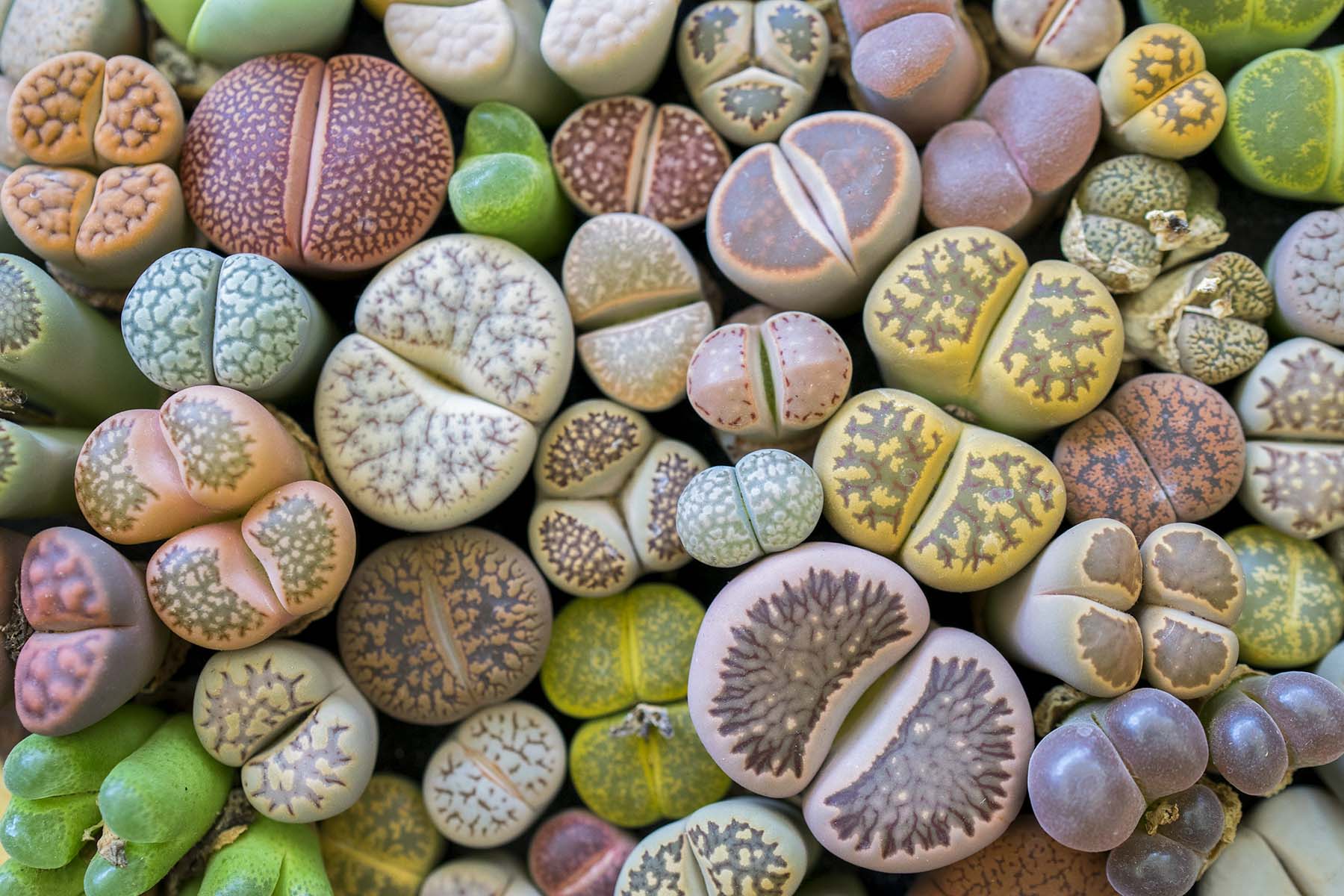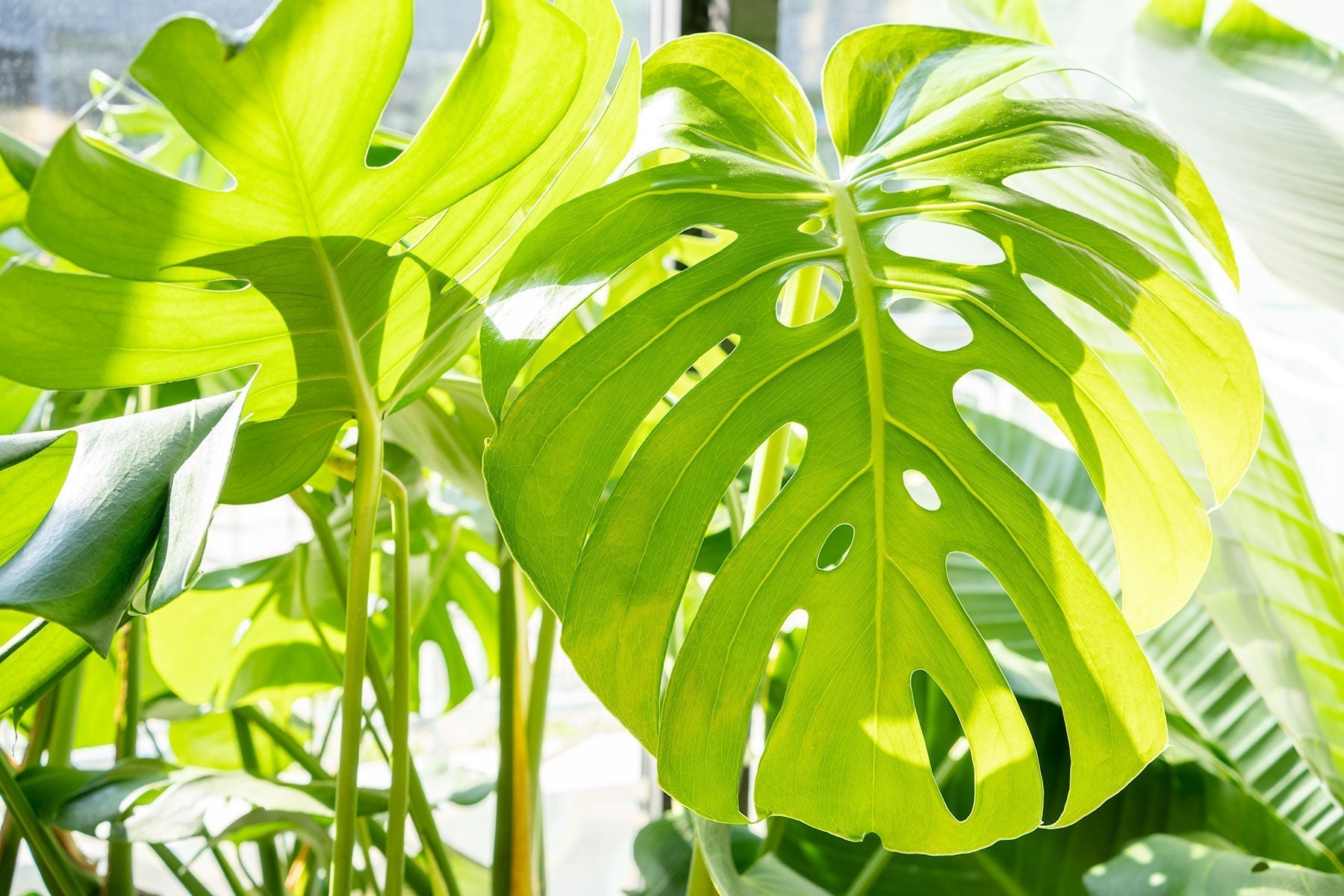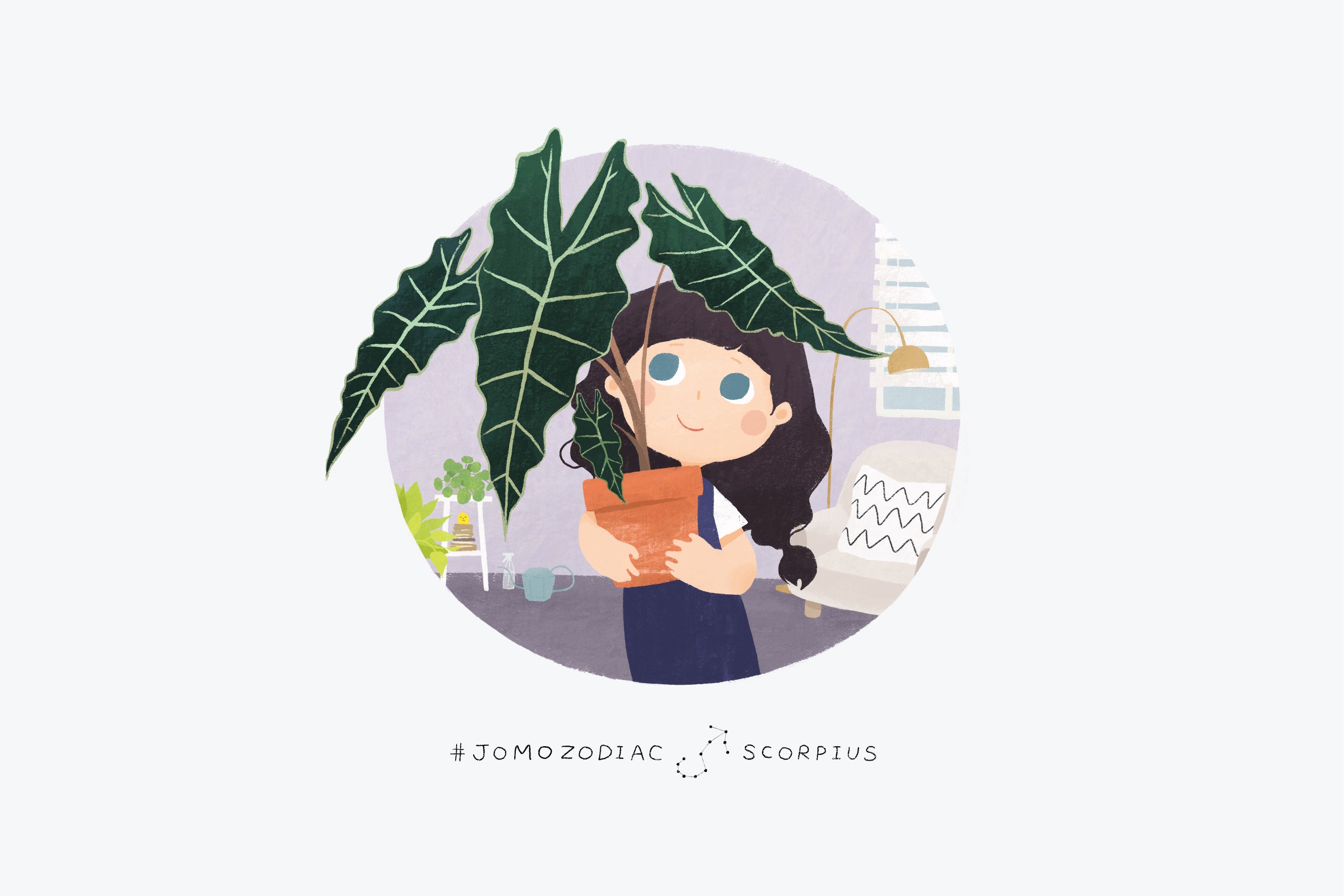
How to Take Care of Your Living Stone: Lithops, Lapidaria and Titanopsis
When looking for a unique, very distinctive-looking plant look no further than Living Stones! These plants naturally look like little stones grouped and nestled in the earth, by design, as a way to disguise themselves from animals looking for moisture in the hot, drought-prone areas they are most often found in southern Africa. Plant parents are drawn towards their particular look they offer, making them a quirky and fun addition to any plant family. They can be finicky when it comes to watering, like most succulents, but this guide will shed more light on that topic further in.
△ Living Stone Lithops
While they all look the same, the Lapidaria is the only type of live stone in this group that is slightly different within the ice plant family, Aizoaceae. The others, Lithops and Titanopsis, will typically only have one pair of leaves, or bulbous, almost fused leaves opposite to each other and hardly any stem, while the Lapidaria has two to four pairs of leaves. The leaves are mainly buried, with a partially or completely translucent top known as a leaf window which allows light to enter for photosynthesis.
Light Requirements
For the Living Stone varieties, the light needs to be bright, at least 3 to 5 hours of bright light, preferably direct, followed by and as many more hours of bright indirect light as you can provide. Not only does it help them to keep their beautiful colours, but it also assists in keeping them full and compact, while encouraging little budding leaves, or babies. This is why it is so important to assess your home environment and see what spaces you have available for living stones. Do you have bright, sunny windowsills? Do you have large windows with an unobstructed view of the sky and sun? Do you have grow lights to supplement the lack of sun in certain windows or through certain periods of the year?
☀️
South, East, and West-facing windows are the optimal windows to keep living stones in.
They will do best in bright light. They enjoy some direct sun, but they'll also do well in bright, indirect light. It is best to place this plant somewhere where it will receive some nice morning sun, or a couple hours of afternoon sun, and then bright, indirect light the rest of the day.
A nice bright place inside your home would be on the window sill or a stool that is right next to a window, with a clear view of the sky and sun. Remember that plants will grow based on how much light they receive. Living Stones grown in bright, direct light will develop hard strongly coloured skins which are resistant to damage and rot, although persistent overwatering is still be enough to cause rot.
△ Living Stone Lapidaria
If you lack any bright windowsills, grow lights are a great alternative to supplement this lack of bright light! Grow lights of certain spectrums can actually bring out the pinks and purples of certain varieties as well, which sunlight won't naturally do by itself. On the other hand, when living stones receive an abundant amount of intense light during the summer months, they may turn pale and go dormant. If this happens, simply move your plant a little further from the window.
💡
Just like any other plant, living stones will begin to grow towards the light, so if they are only receiving light from one side, consider rotating your plant every week or so to encourage even growth.
When living stones are placed in light levels that are too low, the growth each plant does produce will be tall, thin, weak and stretched out, reaching for whatever light it can get, rather than the short, compact growth we gravitate towards them for. Ideally, you would want to gradually extend its exposure to more light so it can photosynthesize enough to produce a new plant and keep the next generation without being stretched.
Living stones should be allocated prime window space, right along a windowsill or as close to the windowsill as possible. Any distance between them and the window will most certainly cause some sort of stretched growth, which is why we emphasize choosing plants that will suit your home.
To check what light your home provides, have a read of our Ultimate Indoor Lighting Guide, and learn more about light and how light levels change throughout the year.
Watering Requirements
The number one way to kill living stones is by watering them too frequently. Without sufficient bright light, they will stretch, but if they receive too much water too often, they will not survive in the long run.
Because they don’t have a stem, a majority of the lithops plant grows underground. This helps the plant retain moisture and means that it doesn’t require constant watering, meaning they can survive for long periods of time on the water stored in their leaves. As with most members of the succulent family, you’ll want to plant your living stones in a pot with good drainage. Overwatering is the main cause of living stone (and succulent) death, so it’s worth watching the signs your lithops is giving you in regard to whether it needs water or not.
During their dormancy throughout the cooler months, where they show little to no signs of new growth, it is extremely important to avoid overwatering.
💦
For living stones in most home environments, with a mild temperate ”t-shirt climate”, is to best keep them completely dry during winter with watering resuming only when the old leaves have dried up and are replaced by a new leaf pair. Watering continues through the fall and when the plant flowers. Stop watering for winter after the flower begins to die.
When it’s ready to be watered, you may see your living stones begin to wrinkle or sink down in the pot, like a grape that has lost its firmness. Give your plant a light squeeze. If it’s soft, it’s time to water. If it is firm, wait a bit longer and test it again. Excessive shrivelling can mean you are waiting too long in between waterings but it is better to water less often than more often.
It’s best with living stones to follow the soak-and-dry method that’s used with other types of succulents. Drench the soil when it’s time to water, then wait until the pot fully dries out before watering again. Living stones like being watered most during late spring and summer, as mentions above, but they may need the occasional watering during the winter. At the height of its growth period in warmer months, you’ll likely find yourself watering once every two weeks (if the plant is in ideal conditions of bright light - with soft direct light). It’s a general rule of thumb to follow, but always make sure the soil is dry before watering to be sure.
💧
If a month has passed without showing signs of wrinkling during the summer months and you haven’t watered them, you can moisten the top layer of the pot to help give the roots a bit of moisture. There’s a chance it is becoming dormant from the heat or natural cycle.
As the watering is somewhat particular, this is why keeping your plant in the proper soil, as well as in the proper lighting, is very important, making sure the soil does not stay too wet for too long. A well-draining soil will have pumice, perlite and sand in it to avoid excessive water retention.
A shallow pot with drainage holes is also essential, providing an exit for extra water as well as allowing for proper airflow, not allowing the soil to stay moist for longer than necessary. Open, glass terrariums are a common type of container to keep living stones and other types of succulents in (it does create a beautiful succulent garden if done correctly), but these should only be used if you are extremely confident in your watering abilities!
✂️
It is common to propagate different living stones via seeds or cuttings, but you can read more about this in our Propagation Series. Cuttings can only be used to produce new plants after a plant has naturally divided to form multiple heads.
Humidity
When it comes to humidity, the living stones aren’t a giant fan. In fact, airflow is important in hot, humid environments. Avoid keeping any living stones in closed terrariums, near vents, radiators or open windows in the winter. Living stones will not need any added humidity to their environment.
🌧️
In most cases, excessive humidity will do more damage than good. Considering their natural environments are dry, arid, desert-like habitats, too much humidity would actually cause fungal, bacteria or rotting issues.
All-in-all, your succulents don't need misting, showering, pebble trays or humidifiers to stay happy, they just need proper lighting and appropriately timed watering.
Fertilizing
△ Living Stone Titanopsis
Another area in which living stones are rather low maintenance is fertilizing. They don't require too much and should really only be fertilized once a month during the growing season, which would be the warmer months of spring and summer. Use a balanced, all-purpose, water-soluble fertilizer (such as an 8-8-8 or 10-10-10) diluted to half the strength recommended on the package instructions. Once the fall rolls around again, stop fertilizing until the next spring!
Toxicity
The majority of succulents are pet-friendly, meaning you shouldn't worry if any inquiring mouths have found their way to snacking on your plants, although we generally recommend keeping them out of reach. However, there are certain varieties to watch out for, such as Euphorbias, Aloe Vera, Jades, Kalanchoe, Senecio, and Cacti, but the Cacti are mainly hazardous due to their sharp spines.
Common Pests & Problems
Living stones stay rather unbothered when it comes to pests, although they can experience a few other issues throughout your ownership of them:
Pests:
Although they are typically not an issue, there are certain pests that can present themselves when it comes to living stones, the most common of which are fungus gnats and mealybugs. Both can likely be caused by overwatering, so we can't stress enough that it is important to let the soil dry between waterings. Mealybugs can also be caused by over-fertilizing, so keep an eye out for fuzzy, white bodies hidden in crevices, as well as stunted, unhealthy or misshapen new growth. For more information on ridding yourselves of these pests, please visit our pest removal guides.
Over-watering:
Next to improper lighting, watering too frequently is probably the biggest living stone killer. They do an incredible job on their own of storing water in their leaves, which is all a part of survival in their natural habitats! Make sure your plant is kept in the appropriate soil with proper drainage and that you are watering as we describe above. Mushy, rotting leaves generally mean too much water and dried up, shrivelled leaves often indicate not enough water.
Leggy growth:
This is almost always an indication of not enough light, along with colour loss, etiolation, and smaller leaves. Keep your plant right on the windowsill, or on a surface right next to a window, and give it as much sunlight as possible.
Sunburn:
If your plant is kept in direct sunlight and has started to turn white and then brown, it is most likely getting sunburnt. White markings mean you have caught it early while brown means it has done more damage. Move your plant to a spot that is still very bright but receives less direct sunlight, giving the plant time for the damage to grow out.
Regardless of their slightly finicky nature, living stones truly don't have too many problems, it is just making sure their environment is correct right off the bat. As long as you have a bright windowsill and you are not an excessive waterer, your living stones should do just fine!









